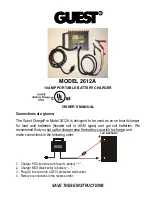
USER MANUAL
v1.1
JEFBTRYCHG020
20A BATTERY CHARGER
•
230V
~
50Hz
www.jeffersontools.com
7
Electrical Safety
Ensure that you check the equipment thoroughly to ensure it is safe and fit for purpose before each use. It is important that
you inspect all plugs, sockets, power cables and electrical fittings for wear and damage and repair or replace any defective
components.
The risk of electric shock can be minimised by the correct use of the appropriate electrical safety devices. If a fuse blows,
ensure it is replaced with an identical fuse type and rating (please refer to the equipment specification plate). Contact Jefferson
Tools for advice and information on genuine parts.
•
We recommend that you fit a
Residual Current Circuit Breaker (RCCB)
in the main distribution
board and that a
Residual Current Device (RCD)
is used when operating this equipment.
•
The
Electricity at Work Act 1989
includes legislation that places legal implications on employers
to ensure the safety of electrical devices in the workplace. The regulations dictate that all portable
equipment must be inspected regularly and tested to ensure that it is safe for use. 'Portable
equipment' means any electrical item that can be moved and this is often referred to as
Portable
Appliance Testing (PAT)
. PAT testing should be carried out regularly on this equipment by trained,
authorised personnel, as required by the legislation.
•
The
Health and Safety at Work Act 1974
states that it is the responsibility of the owner of electrical
appliances to ensure that both the equipment and working environments are maintained to ensure
safe operation at all times.
•
Check that all equipment cables are secure, correctly insulated, free from damage, and protected against short circuit and overload before
connecting to the power supply. Do not use worn or damaged cables, plugs, sockets or other fittings.
•
Ensure that the power supply matches voltage requirements specified on the equipment and that the plug is wired correctly and fitted with
the correct fuse.
•
If the electrical fuse blows, ensure it is replaced by an identical type of fuse with the same rating.
•
Never pull or manoeuvre this equipment into position using the power cable.
•
Ensure the power cable is kept away from heat, oil and sharp edges.
•
We recommend that the equipment is connected directly to the power supply without the use of extension leads as the resulting voltage drop
can reduce performance.
•
Always disconnect the charger from the power source and disconnect the charging clamps before servicing, inspecting, maintaining,
cleaning, replacing or checking any parts.
•
Do not use the charger in damp or wet conditions.
ELECTRICAL WIRING DIAGRAM
Cable Grip
Neutral
Wire
(Blue)
Earth
Wire
(Brown)
Earth Wire
(Yellow
& Green)
3 Amp
Fuse


































